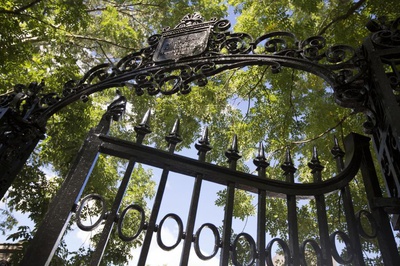
News
Harvard Researchers Develop AI-Driven Framework To Study Social Interactions, A Step Forward for Autism Research

News
Harvard Innovation Labs Announces 25 President’s Innovation Challenge Finalists

News
Graduate Student Council To Vote on Meeting Attendance Policy

News
Pop Hits and Politics: At Yardfest, Students Dance to Bedingfield and a Student Band Condemns Trump

News
Billionaire Investor Gerald Chan Under Scrutiny for Neglect of Historic Harvard Square Theater
Botanists Establish Origin of Corn
Discovery of fossilized grains of 60,000 year old corn pollen 200 feet beneath Mexico City last year has definitely established that corn is a native of the Western Hemisphere and did not originate in Asia, four University botanists announced Saturday.
The origin of corn, America's most important food plant, has puzzled botanists for more than a century.
At the same time, the scientists also said that corn is not a descendant of a Mexican grass called teosinte. This grain, however, has had an important place in the development of modern corn through natural hybridization processes, the botanists added.
Final Evidence
By mating modern corn and teosinte, a synthetic hybrid corn cob was developed which closely matched, in size and botanical characteristics, prehistoric corn cobs found in caves in the southwestern United States.
The University botanists concerned with the research include Paul C. Mangelsdorf, professor of Botany; Elso S. Barghoorn, associate professor of Botany; Walton C. Galiuat, a research follow; and Miss Margaret Wolfe of Radcliffe.
The discovery of the 60,000 year-old pollen last year was the final evidence the scientists needed to prove that corn originated in this hemisphere.
In 1950, the oldest and most primitive corn cobs--scarcely larger than a one-cent piece--were found in Bat Cave, N.M. They are estimated to date from 3000 to 3900 B.C., the botanists revealed. The plant bearing these cobs was thought to be a slender shoot, one or two feet in height.
Comparison Made
By comparing the Bat Cave cobs with later corn known to have been crossed with teosinte, the scientists obtained evidence of the value of teosinte. In addition, they experimentally proved that cross-breeding with teosinte causes corn to mutate and increase in variability, thus becoming more susceptible to human selection.
The Mexico City corn pollen fossils were found in drill cores studied by Dr. Paul Sears of Yale and Mrs. Kathryn Clisby of Oberlin College. The Bat Cave corn was found by Herbert Dick, then of Colorado State Museum.
Want to keep up with breaking news? Subscribe to our email newsletter.
Most Read
- More Than $110 Million in NIH Grants to Harvard, Affiliated Hospitals Terminated Since Late February
- After Trump’s Demands, Dean of Students Says College Diversity Offices Have No Plans To Cut Programming
- Harvard Is Turning Its Back on Scholasticide in Palestine
- Pritzker Says Harvard Is ‘All Over’ Supporting Students Whose Visas Were Revoked
- Visas Revoked for 4 More Harvard Students and 3 Recent Grads, Bringing Total to 12
From Our Advertisers

Over 300+ courses at prestigious colleges and universities in the US and UK are at your disposal.

Where you should have gotten your protein since 1998.

Serve as a proctor for Harvard Summer School (HSS) students, either in the Secondary School Program (SSP), General Program (GP), or Pre-College Program.

With an increasingly competitive Law School admissions process, it's important to understand what makes an applicant stand out.

Welcome to your one-stop gifting destination for men and women—it's like your neighborhood holiday shop, but way cooler.

HUSL seeks to create and empower a community of students who are seeking pathways into the Sports Business Industry.
